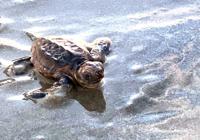October was the official end of sea turtle nesting season in South Carolina. It was a successful season, with more than 5,500 nests on the state’s beaches, although nothing like last year, when a record 8,797 nests were laid.
On the beaches at the Isle of Palms and Sullivan’s Island there is a veritable army of volunteers watching over loggerhead sea turtle nests from March through October. Mary Pringle, Isle of Palms Project Leader says she has “about 180 volunteers just on the Isle of Palms and Sullivan’s Island who patrol the beach every morning at dawn and look for signs that a nest has been laid. They check on the nests that are out there to see if there are any problems and look to see if a nest has hatched.”
This is not a task anyone can do, she explains, “We have a permit from the Department of Natural Resources to find and protect all of the loggerhead sea turtle nests that are laid on Sullivan’s Island and Isle of Palms. Lately that has involved locating the eggs in the morning after the turtle lays them in the night. Very often we are relocating them to a safe spot where they will incubate and hatch without being destroyed.”
Asked if people are the problem for the hatchlings she surprisingly said “No, not at all.” We mark them (the nests) with a sign and rope off the small area where the egg chamber is underground. We haven’t had any trouble with people. We make sure they are in a safe place. If they are not in a safe place it’s usually the tide (that’s the problem) and we did have a little bit of coyote interaction with our nests this year.”

A loggerhead hatchling who came out of Nest #35 which was laid near 7th Avenue on the Isle of Palms.
She said all the beaches in South Carolina are having a problem with coyote predation this year. To prevent the coyotes from destroying the nests the volunteers put up a plastic four-by-four feet screen over the area. “We stake it down with 12-inch tent stakes so that they can’t get to the nest and dig into it.” The hatchlings can get out because the holes in the screen are large enough to accommodate their two-inch size. “They can just come right up through the screen and get to the water when they need to. They don’t get trapped in there because of the screen,” Pringle said.
COVID-19 had some impact on the beginning of the nesting season’s volunteer force. There was an initial shutdown of preseason activities, according the South Carolina Department of Natural Resources (SCDNR).
“It was touch and go at the beginning of the season,” said SCDNR biologist Michelle Pate, who heads the agency’s sea turtle nesting work. “We needed to determine how to engage our large volunteer networks in this important conservation work while ensuring we did not put their health at risk. As usual, our many dedicated volunteers rose to the challenge to collect another valuable season of data and ensure a successful outcome for nests.”
Pringle said this year Isle of Palms had 40 nests and Sullivan’s Island had eight. “That’s about an average year. We begin patrols on May 1. That’s when the first nest in the state is usually laid and then stop patrols on Aug 15.
"But the nests continue to hatch out. It takes about two months for each nest to hatch, so they don’t finish hatching and getting to the water until the end of September to the beginning of October usually.”
Starting out as a “beach walker” in 1998 Pringle became the project leader after several years. “These are an endangered species, so we have to have a permit interact with them at all. Our beach walkers, we couldn’t do it (our work) without them helping and patrolling both islands to keep up with these turtles. You never know when or where they’re going to come ashore during the night to lay eggs.”
The Link LonkNovember 05, 2020 at 04:26AM
https://ift.tt/350QMfP
Isle of Palms and Sullivan's Island had a successful sea turtle nesting season - Charleston Post Courier
https://ift.tt/2CoSmg4
Sea
/cloudfront-us-east-2.images.arcpublishing.com/reuters/CZF6NULMVVMEXHOP7JK5BSPQUM.jpg)
No comments:
Post a Comment